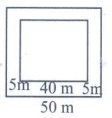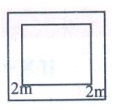Questions with Answers, Solution | Algebra | Term 3 Chapter 3 | 7th Maths - Exercise 3.3 | 7th Maths : Term 3 Unit 3 : Algebra
Chapter: 7th Maths : Term 3 Unit 3 : Algebra
Exercise 3.3
Exercise
3.3
Miscellaneous Practice problems
1. Using identity, find the value of
( i) (4.9)2
(ii) (100.1)2
(iii) (1.9)×(2.1)
Solution:
(i) (4.9)2
(4.9)² = (5 – 0.1)2
Substituting a = 5 and
b = 0.1 in
(a – b)² = a² – 2ab + b², we have
(5 – 0.1)² = 5² – 2 (5) (0.1) + (0.1)2
(4.9)2 = 25 – 1 + 0.01 = 24 + 0.01
(4.9)2 = 24.01
(ii) (100.1)2
(100.1)2 = (100 + 0.1)2
Substituting a = 100
and b = 0.1 in
(a + b)2 = a2 + 2ab + b2, we
have
(100 + 0.1)2 = (100)2 + 2 (100) (0.1) +
(0.1)2
(100.1)2 = 10000 + 20 + 0.01
(100.1)2 = 10020.01
(ii) (1.9) × (2.1)
(1.9) × (2.1) = (2 – 0.1) × (2 + 0.1)
Substituting a = 100
and b = 0.1 in
(a – b)(a + b) = a2 – b2,
we have
(2 – 0.1)(2 + 0.1) = 22 – (0.1)2
(1.9) × (2.1) = 4 – 0.01
(9.9) (2.1) = 3.99
2. Factorise : 4x 2
− 9 y2
Solution:
4x2 – 9y2 = 22 x2 – 32 y2 = (2x)2 – (3y)2
Substituting a – 2x and b = 3y in
(a2 – b2) = (a + b) (a – b), we have
(2x)2 – (3y)2 = (2x + 3y) (2x – 3y)
∴ Factors of 4x2
– 9y2 are (2x + 3y)
and (2x – 3y)
3.
Simplify using identities (i) (3 p + q )(3 p +r) (ii)
(3 p + q )(3p − q)
Solution:
(i) (3p + q)(3p + r)
Substitute x = 3p, a
= q and b = r in
(x + a) (x
+ b) = x2 + x(a
+ b) + ab
(3p + q)(3p
+ r) = (3p)2 + 3p (q
+ r) + (q × r)
= 32 p2
+ 3p (q + r) + qr
(3p + q)(3p
+ r) = 9p2 + 3p (q
+ r) + qr
(ii) (3p + q)(3p – q)
Substitute a = 3p
and b = q in
(a + b) (a – b) = a2 – b2,
we have
(3p + q)(3p
– q) = (3p)2 – q2 = 32p2 – q2
(3p + q)(3p – q) = 9p2 – q2
4.
Show that (x + 2 y)2 −(x
− 2y)2
=8xy
Solution:
[∵ (a + b)2 = a2 + 2ab + b2
(a – b)2 = a2 – 2ab + b2]
LHS = (x + 2y)² – (x – 2y)²
= x² + (2 × x × 2y)
+ (2y)² – [x² – (2 × x × 2y) + (2y)²]
== x² + 4xy + 4y² –[x² – 4xy + 2² y²]
= x² + 4xy + 4y² – x² + 4xy –4 y²
= x² – x² + 4xy + 4xy + 4y² – 4y²
= x² (1 − 1) + xy (4 + 4)
+ y² (4 − 4)
= 0x² + 8xy + 0y² = 8xy = RHS
∴ (x + 2y)² – (x – 2y)² = 8xy
5.
The pathway of a square paddy field has 5 m width and length of its side
is 40 m. Find the total area of its pathway. (Note: Use suitable identity)
Solution:
Given side of the square = 40 m
Also width of the pathway = 5 m

∴ Side of the larger square =. 40m + 2(5)m = 40m + 10m = 50m
Area of the path way = area of large square – area of smaller
square
= 502 – 402
Substituting a = 50
and b = 40 in
a2 – b2 = (a + b)(a – b) we have
502 – 402 = (50 + 40) (50–40)
Area of pathway = 90 × 10
Area of the pathway = 900 m2
Challenge
Problems
6.
If X = a2 −1 and
Y = 1 −b2 , then
find X +Y and factorize the same.
Solution:
Given X = a2
– 1
Y = 1 – b2
X + Y = (a2–
1) + (1 – b2)
= a2 – 1 +
1 – b2
We know the identity that a2
– b2 = (a + b) (a – b)
∴ X + Y = (a + b) (a – b)
7.
Find the value of (x − y )(x + y)(x2
+ y2
)
Solution:
We know that (a – b) (a + b) = a2 – b2
... (1)
Put a = x and b = y in the identity (1)
then
(x – y)(x + y) = x2 – y2
Now (x – y) (x + y)(x2 + y2)
= (x2 – y2) (x2 + y2)
Again put a = x2 and b = y2 in (1)
We have (x2 –
y2) (x2 + y2)
= (x2)2 – (y2)2 = x4 – y4
So (x – y)(x + y) (x2 + y2)
= x4 – y4
8.
Simplify (5x − 3 y)2 −(5x
+3y)2
Solution:
We have the identities …….. (1)
(a + b)2 = a2 + 2ab + b2
(a – b)2 = a2 – 2ab + b2
So (5x – 3y)2 – (5x + 3y)2 = (5x)2 – (2 × 5x × 3y)
+ (3y)2 – [(5x)2 + 2(5x) (3y) + (3y)2]
= 52x2
– 30xy + 32y2 – [52x2 – 30xy + 32y2]
= 25x2 – 30xy + 9y2 – [25x2
+ 30xy + 9y2]
= 25x2 – 30xy + 9y2 – 25x2
– 30xy – 9y2
= x2 (25–25)
– xy (30 + 30) + y2 (9 – 9)
= 0x2 – 60xy + 0y2 = – 60 xy
∴ (5x – 3y)2 – (5x + 3y)2 = –60xy
9.
Simplify: (i) (a+b)2 – (a–b)2 (ii) (a+b)2 + (a–b)2
Solution:
Applying the identities
(a + b)2 = a2 + 2ab + b2
(a –b)2 = a2 – 2ab + b2
(i) (a + b)2
– (a –b)2 = a2 + 2ab + b2– [a2 – 2ab + b2]
= a2 + 2ab + b2–
a2 + 2ab – b2
= a2 (1 – 1
) + ab (2 + 2 ) + b2 ( 1 – 1)
= 0a2 + 4ab + 0b2 = 4ab
(a + b)2 –
(a –b)2 = 4 ab
(ii) (a + b)2
+ (a –b)2 = a2 + 2ab + b2 + (a2 – 2ab + b2 )
= a2 + 2ab + b2
+ a2 – 2ab + b2
= a2 (1 + 1
) + ab (2 – 2 ) + b2 ( 1 + 1)
= 2a2 + 0ab + 2b2 = 2a2 + 2b2 = 2 (a2
+ b2)
∴ (a + b)2 –
(a – b)2 = 2(a2 + b2)
10.
A square lawn has a 2 m wide path surrounding it. If the area of the path
is 136 m2 , find the area of lawn.
Solution:
Let the side of the lawn = a
m
then side of big square = (a
+ 2(2))m
= (a + 4)m

Area of the path = Area of large square – Area of smaller square
136 = (a + 4)2
– a2
136 = a2 +
(2 × a × 4) + 42 – a2
136 = a2 +
8a + 16 – a2
136 = 8a + 16
136 = 8 (a + 2)
Dividing by 8
17 = a + 2
Subtracting 2 on both sides
17 – 2 = a + 2 – 2
15 = a
∴ Side of small square = 15m
Area of Square = (Side × Side) Sq. units.
∴ Area of the lawn = (15 × 15)m2 = 225 m2
∴ Area of the lawn = 225 m2
11. Solve the following inequalities.
(i) 4n + 7 ≥ 3n + 10, n
is an integer.
(ii) 6(x + 6) ≥ 5(x − 3),
x is a whole number.
(iii)
−13 ≤ 5x + 2 ≤ 32, x is an integer.
Solution:
(i) 4n + 7 > 3n + 10, n is an integer.
Subtracting 3n both
sides
4n + 7 – 3n ≥ 3n + 10 – 3n
n(4 – 3) + 7 ≥ 3n + 10 – 3n
n (4 – 3) + 7 ≥ n (3 – 3) + 10
n + 7 ≥ 10
Subtracting 7 on both sides
n + 7 – 7 ≥ 10 – 7
n ≥ 3
Since the solution is an integer and is greater than or equal to
3, the solution will be 3, 4, 5, 6, 7,...
n = 3, 4, 5, 6, 7,...
(ii) 6(x +6) ≥ 5(x – 3), x is a whole number.
6x + 36 ≥ 5x – 15
Subtracting 5x on both
sides
6x + 36 – 5x ≥ 5x
– 15 – 5x
x(6 – 5) + 36 ≥ x (5 – 5)
– 15
x + 36 ≥ – 15
Subtracting 36 on both sides
x + 36 – 36 ≥ –15 –36
x ≥ –51
The solution is a whole number and which is greater than or
equal to –51
∴ The solution is 0, 1, 2, 3, 4,...
x = 0, 1,2, 3, 4,...
(iii) –13 ≤ 5x + 2 ≤ 32, x is an integer.
Subtracting throughout by 2
–13 –2 ≤ 5x + 2 – 2 ≤ 32
– 2
–15 ≤ 5x ≤ 30
Dividing throughout by 5
–15/5 ≤ 5x/5 ≤ 30/5
– 3 ≤ x ≤ 6
∴ Since the solution is an integer between –3 and 6 both
inclusive, we have the solution as –3, –2, –1,0, 1,2, 3, 4, 5, 6.
i.e. x = –3, –2, 0, 1,
2, 3, 4, 5 and 6.
ANSWERS:
Exercise 3.3
1. (i) 24.01 (ii)
10020.01 (iii) 3.99
2. (2x + 3y)
(2x – 3y)
3. (i) 9p2
+ 3p (q + r) + qr (ii) 9p2
– q2
4. 900 sq.m
Challenge problems
6. (a – b) (a + b)
7. x4 – y4
8. –60xy
9. (i) 4ab (ii) 2(a2
+ b2)
10. 225 sq.m
11. (i) n = 3, 4, 5, 6, .... (ii) x = 0, 1, 2, 3, ... (iii) x = –3, –2, –1, 0, 1, 2, 3,
4, 5 and 6
Related Topics